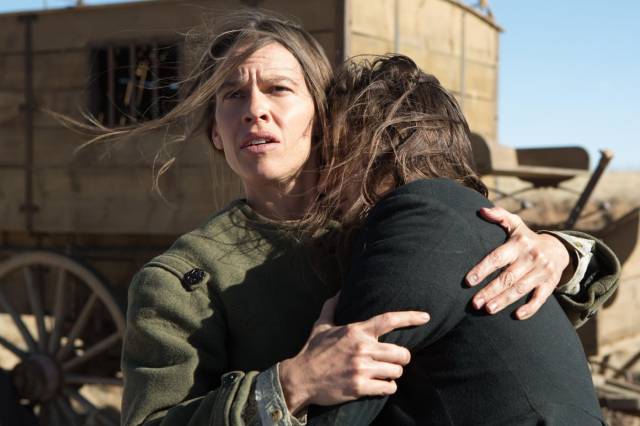
 In The Homesman, Hilary Swank plays Mary Bee Cuddy, a middle-aged spinster living by herself in the Nebraskan farm she owns. Despite her land ownership and relative wealth, no man in the region will marry her on account of her poor looks and bossiness, leaving her to a life that would be considered revolutionary and even enviable to a certain degree in our times, but that in the 19th century made her seem incomplete. During one of the film’s very first scenes we see her try to make a case of marriage to a neighbor who rejects her, and we understand this isn’t even the first time she’s proposed to a man. Mary finds a sense of purpose when she gives herself the hard task of escorting three local women (played by Grace Gummer, Miranda Otto and Sonja Richter) showing signs of insanity, to an asylum in Iowa.
In The Homesman, Hilary Swank plays Mary Bee Cuddy, a middle-aged spinster living by herself in the Nebraskan farm she owns. Despite her land ownership and relative wealth, no man in the region will marry her on account of her poor looks and bossiness, leaving her to a life that would be considered revolutionary and even enviable to a certain degree in our times, but that in the 19th century made her seem incomplete. During one of the film’s very first scenes we see her try to make a case of marriage to a neighbor who rejects her, and we understand this isn’t even the first time she’s proposed to a man. Mary finds a sense of purpose when she gives herself the hard task of escorting three local women (played by Grace Gummer, Miranda Otto and Sonja Richter) showing signs of insanity, to an asylum in Iowa.
The trip, which could take up to two months, will represent her ultimate achievement, not only because she will outdo all the cowardly men who deemed themselves unfit for the task, but also because she will be helping these women find the inner peace she’s been denied. Upon leaving Iowa, Mary runs into claim jumper, George Briggs (Tommy Lee Jones) whom she recruits to help her out in the journey. Their relationship starts off as an odd-couple situation, but slowly reveals itself to be something much more complex, as the film forgoes the path of becoming an adventure Western and turns into a thoughtful character study.
Languorously shot by Rodrigo Prieto, who is able to turn the darkness of the small wagon carrying the women into a safe haven or the very confines of hell just by changing the camera angle, The Homesman is a confident directorial effort from Jones, who is smart enough to give himself the least showy role in the picture and concentrates on the elements that make it one of very few modern feminist Westerns. Adapted from Glendon Swarthout’s novel, the film focuses on the unfair treatment of women in the 19th century and allow us to see how illnesses like depression were often treated as lunacy. The cast is exceptional, with Richter, Gummer and particularly Otto, bringing a sense of utter heartbreak to these women.
And as terrific as Jones is, the film belongs to Swank, who once more excels in a part that requires her to highlight her masculine features to follow the same path of the tragic characters she’s become most famous for playing. Swank’s unique beauty is undeniable, but as Mary she brings afloat issues of self worth and distorted self image that are relevant today as they were during the era when the film takes place.